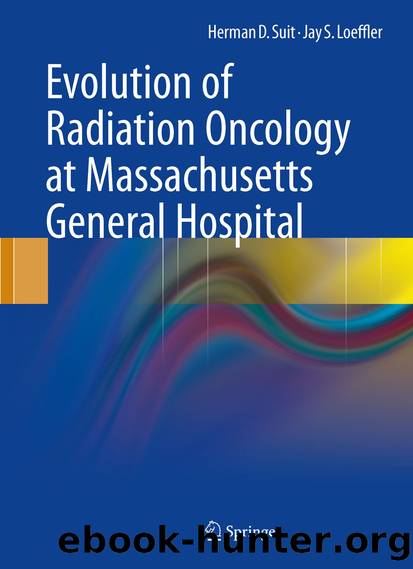Evolution of Radiation Oncology at Massachusetts General Hospital by Herman D. Suit & Jay S. Loeffler

Author:Herman D. Suit & Jay S. Loeffler
Language: eng
Format: epub
Publisher: Springer US, Boston, MA
8.3.3 Leo Gerweck
Leo became a member of the laboratory research program in 1974 shortly after receiving his Ph.D. from Colorado State University with W. Dewey as his thesis advisor. For his Ph.D., he determined that sensitivity to hyperthermia increased inversely with pH. Further, at defined metabolic conditions, hyperthermic sensitivity was independent of pO2. Additionally, S phase cells were of increased sensitivity to hyperthermia in contrast to their relative radiation resistance to radiation as shown by the paper with Dewey in 1977 [18]. Importantly, as solid tumors contain large fractions of hypoxic cells and those cells are at low pH levels, i.e., increased sensitivity to hyperthermia, there was a sound rationale to combine hyperthermia and radiation against human tumors judged or measured to have an important fraction of cells that are hypoxic. As we are aware, radiation is relatively quite effective against aerobic cells but much less so against hypoxic cells. See his papers of the early 1970s [31, 32]. This treatment strategy has not had serious clinical testing due to the great difficulty of achieving a known and reasonably uniform distribution of hyperthermia in human tumors.
Gerweck extended his studies on hyperthermia to determine the impact of pH on weakly acidic and weakly basic chemotherapy agents. The intra-cellular pH of tumor cells is similar to that for normal cells. In contrast, the extracellular fluid of tumors is more acid than that of normal tissues. He increased extracellular pH gradient in a tumor by 0.2 pH units. This caused the ratio of the chloroambucil to doxorubicin-induced delay in growth of tumor 54A in NCr/Sed/nu/nu mice to be increased by a factor of 2.1 as he reported in 2006 [33].
More recently, he has been quite active in the investigation of the role of radiation killing of tumor cells vs endothelial cells as determinants of tumor response. He and associates investigated a methylcholanthrene-induced sarcoma in SCID mice. The SCID mice are deficient in repair of DNA double-strand breaks and accordingly their normal tissues and tumors are more radiation sensitive than comparable tissues in normal mice by factors of 2–3. Gerweck et al. employed one cell line derived from a SCID sarcoma (sensitive) and two sub-lines that they had transfected with the repair gene DNA-PKcs. Thus, they had a sensitive cell line (DNA Pkse−/− negative) and two resistant cell lines (DNA Pkse+/+), viz., FSC1−3 vs T53 and T43. The normal SCID cell line and the transfected cell lines differed in only one gene. The parent cell line, FSC1−3, was more sensitive than T53 and T43 cell lines in vitro by factors of 1.5 and 2.5. The tumor growth delay (TGD) for FSC1−3 tumors in NCr nu/nu mice was 1.5 that of T53. T43 was tested in SCID mice; the increase in TGD was by a factor of 2.1. They did not employ long-term local control as an end-point, but are currently examining this end-point. There was a similar ratio of tumor growth delay of transplants in NCr/Sed/nu/nu mice. These results were interpreted as indicating that
Download
This site does not store any files on its server. We only index and link to content provided by other sites. Please contact the content providers to delete copyright contents if any and email us, we'll remove relevant links or contents immediately.
When Breath Becomes Air by Paul Kalanithi(7261)
Why We Sleep: Unlocking the Power of Sleep and Dreams by Matthew Walker(5639)
Paper Towns by Green John(4168)
The Immortal Life of Henrietta Lacks by Rebecca Skloot(3824)
The Sports Rules Book by Human Kinetics(3585)
Dynamic Alignment Through Imagery by Eric Franklin(3487)
ACSM's Complete Guide to Fitness & Health by ACSM(3467)
Kaplan MCAT Organic Chemistry Review: Created for MCAT 2015 (Kaplan Test Prep) by Kaplan(3422)
Introduction to Kinesiology by Shirl J. Hoffman(3299)
Livewired by David Eagleman(3121)
The River of Consciousness by Oliver Sacks(2992)
Alchemy and Alchemists by C. J. S. Thompson(2911)
The Death of the Heart by Elizabeth Bowen(2900)
Descartes' Error by Antonio Damasio(2731)
Bad Pharma by Ben Goldacre(2727)
Kaplan MCAT Behavioral Sciences Review: Created for MCAT 2015 (Kaplan Test Prep) by Kaplan(2491)
The Gene: An Intimate History by Siddhartha Mukherjee(2491)
The Fate of Rome: Climate, Disease, and the End of an Empire (The Princeton History of the Ancient World) by Kyle Harper(2434)
The Emperor of All Maladies: A Biography of Cancer by Siddhartha Mukherjee(2430)
